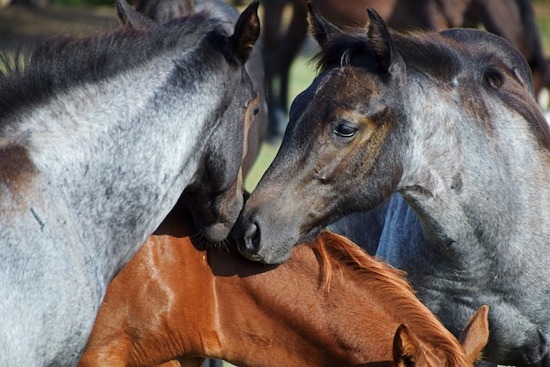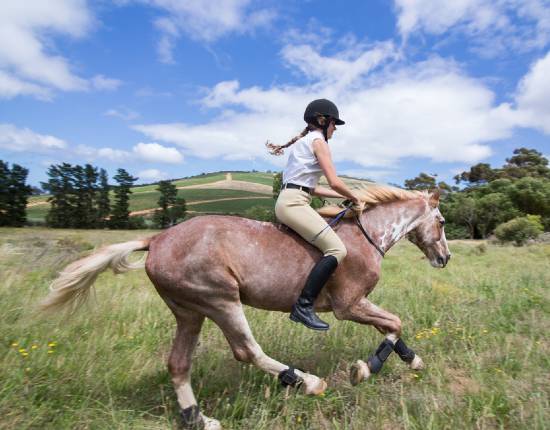Affiliate Disclaimer
As an Amazon Associate I earn from qualifying purchases. It helps me keep the website going. Thank you for your support.
More than any specific type or breed of horse, roan is a patterned hair color composition in the coat. Identified by white and colored hairs that are intermixed throughout the body, the lower legs, mane, and tail remain in a solid color. But the term roan refers to a range of colors, and as such there are different types of roan horses.
A specific gene type must be present in a true roan, but the most commonly known and recognized roan colors are red and blue. There are, however, other types of roan horses, including bay roan, chestnut roan, and gray roan.

Main Types of Roan Horses
Here are three of the most important types of roan horses…
Red Roan
The color format of a red roan is identical to a sorrel or chestnut but with a uniform mixture of red and white hairs on their body and a red head and legs. They may have a red or flaxen mane and tail.
Blue Roan
The blue roan’s markings are identical to that of a black horse and, to some extent a brown, with a uniform mixture of black and white hairs and also darker on the head and legs. They can have a few red hairs in the mixture.

Bay Roan
Like the red roan, bay roans have a uniform mixture of white and brown or reddish hairs on a large portion of the body and a darker head, but they also have black points. Black points mean black lower legs and a black mane and tail.
Like the roan gene, black points must be inherited from at least one parent who displays the same color markings.
Other Colors Mistaken for Roan
Some types of horses get mistaken for being roan. Here are a few examples:
Rabicano
Rabicano is the name given to a particular pattern of white marks on the horse’s body. This trait is often expressed in the form of white flecks of hair on the base of the horse’s tail. However, it can also show up on the belly of the horse or the flanks.
Caused by a different gene than roan, the Rabicano color appears as white flecking. It is often called either skunk-tail or sometimes coon-tail. This is because of its striping or “white frosting” at the tail base.
If the contrast of colors is more pronounced, it can have a white tail base as well as the white hair intermixed pattern over its flanks, giving it a roan appearance.
Sometimes a Rabicano can look like a true roan if the contrast is extremely expressed.
It can carry the coon-tail and have roaning on the body, concentrated on the flanks and under the elbows, and also have vertical strips of white on the barrel called rib barring.

Sabino
Then there is a final hair color pattern that can be confused with both roan and Rabicano called Sabino.
Although the roan effect can be seen on the flanks and body of a Sabino, it is an altogether different gene.
To distinguish it from Rabicano is easy because Rabicano always has white in some quantity at the base of the tail and Sabino does not.
What makes Sabino coloring special is that there is almost always a white spot on the chin, white socks, and some facial white as well as the roan on the body.
It is possible for the horse to carry multiple genes, for example, to be both rabicano and sabino (source).
The roan gene isn’t exclusive to the solid colors already mentioned, but lighter colors like palomino make the roaning harder to see.

Are Roans Born Colored?
Most roan horses are born with a solid color coat, which may or may not show any white markings.
They begin to show signs of roaning within the first few weeks to months of life, and the degree of roaning typically increases as the horse ages.
The exact age at which a horse displays a full roan coat varies depending on the individual horse, but it generally occurs between 2 and 5 years of age.
At this age, the horse will have a coat that is a mixture of solid-colored hairs and white hairs, giving the coat a roaned or mottled appearance.
Roan usually covers the whole of the horse’s body, with the head and legs unaffected.
If a roan horse sustains an injury, when the wound heals, it will heal over in the horse’s base color. An example would be that a red roan’s scar heals over, and red or sorrel hair will grow back.
An injured solid sorrel horse, on the other hand, would most likely grow in white scar hair.
The Winter coat is different in that the base coat color will grow longer, but not the roan hair, so the horse will appear darker then and lighter in the Summer.
The Roan Color’s Origin Story
The origin of roan horses, as mentioned before, is not attributed to a specific breed, but rather to a coloration pattern that occurs in various breeds.
According to the American Quarter Horse Association (AQHA), the roan coloration is believed to have originated in Europe, with evidence of roan horses dating back to the 16th century.
However, the specific breeds that contributed to the development of roan horses are unclear.
The Encyclopedia of the Horse suggests that the roan coloration may have been influenced by breeds such as the Andalusian, which were known for their “dapple grey” coat patterns.
The book also mentions the role of the Irish Draft and Welsh Cob breeds in producing roan horses with a more “heavyset” build.
Overall, the roan coloration pattern can be found in a variety of breeds, including but not limited to the American Quarter Horse, Thoroughbred, Arabian, and Appaloosa.
The exact origins of the roan pattern may remain somewhat of a mystery, but it is clear that this unique coloration has been appreciated by flashy horse lovers for centuries.
Types of Roan Horses in Different Breeds
Not all breeds of horses necessarily have all types of roan coloring and there are over 150 breeds of horses, including mules, that are known to carry and/or exhibit the roan gene.
Whether a breed exhibits a particular type of roan coloration depends on whether the breed carries the specific gene(s) responsible for that type of roan coloration.
Plus, the frequency of roan coloring in different breeds may vary.
Below are some examples of breeds and their commonly associated roan colorations:
- American Quarter Horse: Red roan, blue roan, bay roan
- Arabian: Bay roan, blue roan
- Thoroughbred: Blue roan
- Tennessee Walking Horse: Red roan, blue roan
- Appaloosa: Red roan, blue roan
- Paint Horse: Red roan, blue roan
- Percheron: Blue roan, gray roan
- Morgan: Bay roan, chestnut roan
- Andalusian: Blue roan
- Haflinger: Chestnut roan
It’s important to understand that these are just general associations, and individual horses within a breed may exhibit different roan colorations depending on their genetic makeup.

Breeding to Produce Types of Roan Horses
Breeding two horses together to create a roan requires selecting horses that carry the roan gene.
Roan is a dominant gene, so at least one of the parents must be a roan for the trait to be passed on. This means that a horse only needs one copy of the roan gene to display the roan coloration.
When a horse with one copy of the roan gene is bred with a horse that also carries the gene, there is a 50% chance that the foal will inherit the gene and display the roan coloration.
To increase the likelihood of producing a roan foal, breeders may select horses that have a history of producing roans or perform genetic testing to determine if the horses carry the roan gene.
Broken down more simply, horse parents with non-classic roan pattern genes will not produce offspring with the roan pattern.
Foals with at least one parent who carries the classic roan pattern gene will have a 50% chance of arriving in the roan coloring.
Two horse parents who test positive for the dominant roan gene are predicted to produce all roan offspring.
Finding Out What Types of Roan Horses Have the Gene
Genetic testing to determine if a horse carries the roan gene is most commonly done using a DNA test which analyzes the horse’s DNA for the presence of the roan gene.
The DNA test is usually performed by collecting a hair sample or a blood sample from the horse, which is then sent to a laboratory for analysis.
The laboratory performs a polymerase chain reaction (PCR) to amplify the DNA and then analyzes the DNA for the presence of the roan gene.
One laboratory that offers a roan gene test for horses is the Veterinary Genetics Laboratory at the University of California, Davis in the United States.
Their test detects the presence of the roan gene and can distinguish between horses that carry one copy of the gene (heterozygous) and those that carry two copies of the gene (homozygous).
Despite a commonly repeated myth that says homozygous roans are born dead, research has proven the existence of living homozygous roan horses.
It’s important to note that genetic testing is not always necessary or recommended for all horses.
Testing should only be done by a qualified veterinarian or geneticist and should be used in combination with other factors when making breeding decisions.
Exclusively Breeding for Color
It is more important to consider the health, temperament, and conformation of the horses being bred.
Breeding solely for color is generally discouraged because it can result in offspring that lack desirable traits or suffer from health problems.
For example, breeding two horses with poor conformation may result in offspring with poor movement, making them unsuitable for certain disciplines.
Similarly, breeding two horses with poor temperaments may result in offspring that are difficult to train and handle, making them less desirable to potential buyers.
Flashy colors are not worth much by themselves.
Final Thoughts
In conclusion, the best news is that types of roan horses come in all different shapes, sizes, and breeds.
What that means is that whichever discipline you enjoy the best, there is probably a breed that will work for you that has a roan color pattern somewhere.
Although some are more common to find than others, it doesn’t mean they are not out there. If you want that bright, flashy mixture of solid and white, you can probably have it.




